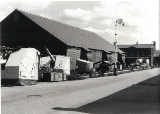
Priddy's Hard
Encyclopedia
Priddy's Hard is an area of Gosport
, in Hampshire
, England
now being developed for housing with part of the site retained as a museum. However, for some two hundred years it was a restricted-access site; first becoming a fort
and then an armaments depot for Royal Navy
and British Army
weapons, explosives and other stores.
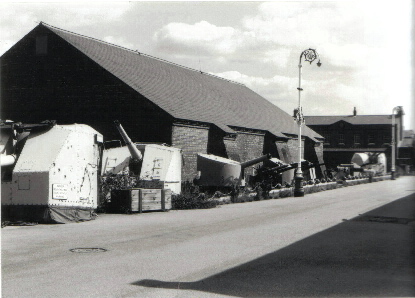
purchased 40 acres (16.2 ha) of agricultural land in Gosport and a boatyard from Jane Priddy and Fareham
Vicar, Thomas Missing. This was to construct an earthen rampart as part of an extension of the defences of Portsmouth Harbour
and the Royal Dockyard, the Gosport Lines. The ramparts were completed in 1757 and the land enclosed known to as Priddy's Hard Fort; it was manned by the Army
. In the nineteenth century Priddy's Hard Fort was armed with 14 eighteen pounder guns.
that had been stored in Square Tower, Portsmouth
.
First. In carrying powder from thence to the hoys about 400 yards (367 m) distance to the end of the point, and by shaking the barrels together in a Cart there has been a train along that street, which in War time is the most popular part of the town.
Second. When funerals pass by there the sparks of the Links and Torches have been seen to fly against the Magazine Walls and Windows.
Third. At shipping off the Powder from the Point among a crowd of drunken, smoking, sailors tending to the Men of Wars boats is also a very great hazard.
Fourth. This Magazine being next to the sea and within reach of Shipping, makes it a good Mark to Bombard where 6000 barrels (953.9 m³) of Powder are lodged.
5th. When Spring Tides come into the Ground Room under the Foundation of the Wall, and strike up damps, which might be cured by Arching over that places; but since the other inconveniences are so great to cause the Ruin of this Place and from miles around: Am humbly of the opinion a New Magazine in the Harbour, free from the said Hazards would be most for the safety of this port.
If the Magazine had exploded the casualties would have been appalling in this densely populated part of Portsmouth
. Serious accidents with gunpowder
were well known, some of them were recorded as follows:
Various proposals were suggested as to where to build the new gunpowder magazine, Priddy's Hard, Boatswain's Hill Coppice (where Defence Munitions Gosport is today), and Horsea Island in the eastern reaches of Portsmouth Harbour. None of the sites were considered ideal, including Priddy's Hard, the main concern the closeness of the Royal Dockyard, this would eventually lead to its final closure.
Priddy's Hard was chosen due to the availability of the land (already owned by the Crown
) and in December 1766 the decision was finally made by the Ordnance Board and the First Lord of the Admiralty
.
Originally the magazine was to be loaded from a rolling-way across the foreshore but it was decided when the time came, to construct a camber basin to enable the lighters to unload right at the rear of the magazine. Further magazines were planned at this juncture to the east and west of the current Grand Magazine, but were never built. This lack of storage capacity was highlighted during the Napoleonic Wars
and as a consequence led to the use of floating gunpowder in the reaches of Fareham Lake.
 Construction of the new powder magazine on land within the ramparts commenced in 1771, along with a cooperage, guardhouse, shifting house barracks and the octagonal camber basin. The Grand Magazine (as it became) was originally enclosed with a high brick wall to assist with security and to ensure no contraband items were brought into the magazine. These items included ferrous objects (to reduce the risk of sparks), alcohol and smoking materials.
Construction of the new powder magazine on land within the ramparts commenced in 1771, along with a cooperage, guardhouse, shifting house barracks and the octagonal camber basin. The Grand Magazine (as it became) was originally enclosed with a high brick wall to assist with security and to ensure no contraband items were brought into the magazine. These items included ferrous objects (to reduce the risk of sparks), alcohol and smoking materials.
Access to the Grand Magazine by hoys (lighters) was a problem from the very beginning. Although the camber basin was constructed with a sluice to help prevent silting up, vessels still had difficulty entering it at any other time than high tide. This problem was solved by the construction of a pier on the eastern side of the camber basin, the remains of which can be seen at low water.
By May 1777, the first powder barrels were moved to Priddy's Hard from Portsmouth's Square Tower. Although six thousand barrels of gunpowder
could be stored there, it was subsequently thought necessary to disperse the ammunition and gunpowder in case the depot ever came under attack. Satellite magazine stores were built to serve this purpose in other locations, but Priddy's Hard remained the most important.
Why it took six years for all of the complex to be completed is not known. The addition of a further two magazines flanking either end and at right angles to the Grand Magazine were cancelled. A possibility for the cancellation may have been the serious fire in the Portsmouth Royal Dockyard in 1776.

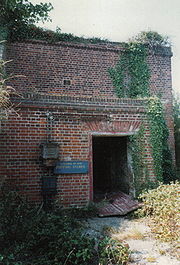 By 1846 Priddy's Hard was still under the control of the Board of Ordnance
By 1846 Priddy's Hard was still under the control of the Board of Ordnance
and the following building existed on the site:
in 1815 and Tipnor in 1830.
During the 19th century further magazines and buildings were added including the installation of a narrow gauge railway system across the whole site and the construction of piers on the Harbour. The site was altered continuously during the early 20th century and it was fully utilised during World War I
and World War II
when thousands of women workers filled jobs vacated by men on active service.
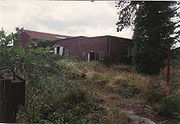
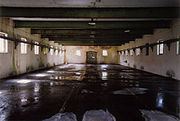
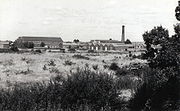 1848 - First Royal Laboratory Complex (Including Office Building and Officer's Quarters.
1848 - First Royal Laboratory Complex (Including Office Building and Officer's Quarters.
1861 - "C" Powder (60 Tons) Magazine.
1866 - Six Shell Filling Rooms.
1879 - "E" Powder (500 Tons) Magazine.
1886 - Shell Filling Rooms.
1887 - Unheading Room.
1888 - Shell Filling Room.
1889 - QF Cartridge Storehouse.
1898 - QF Cartridge Storehouse.
1900 - Proof House.
1900 - QF Cartridge Storehouse.
1900 - Dry Guncotton (50 Tons) Magazine.
1900 - Wet Guncotton (360 Tons) Magazine.
1901 - Mine Storehouse & Exam Rooms.
1900 - 1906 - Cordite Magazines 454, 357 & 358.
1901 - Twelve Cartridge Rooms.
1902 - Room for the Conversion of Dangerous Ammunition.
1904 - Shell Emptying Room.
and zinc
, (brass
) plus a little iron, as a precaution against sparks. A remnant of the line behind store N.372 shows it had grooved rails set flush with ground level. In 1904 it had 78 trucks. It was superseded by the 30 inches (762 mm) line; but part continued in use inside some workshops and stores to about 1960.

 Priddy's Hard became the oldest of several depots (including former Ordnance Depots Marchwood, Tipnor Magazine & Dean Hill) now making up the complex of the Royal Naval Armament Depot (RNAD) Gosport, latterly retitled Defence Munitions Gosport.
Priddy's Hard became the oldest of several depots (including former Ordnance Depots Marchwood, Tipnor Magazine & Dean Hill) now making up the complex of the Royal Naval Armament Depot (RNAD) Gosport, latterly retitled Defence Munitions Gosport.
For many years, Priddy's Hard was both the Royal Navy's and regional Army's armaments depot and supplier of ordnance and training to Commonwealth and Foreign countries, though its significance decreased over time. The site was last used for significant naval activity during the Falklands Conflict in 1982, and was vacated by RNAD Gosport in 1988 when the last remaining stores and staff were relocated.
The site was redeveloped for housing, though some of it was retained for Explosion!, the new Museum of Naval Firepower, though the fort ramparts
have been left in recent years to become overgrown and often set alight by vandals. The former laboratory buildings (some of which were to be retained for historical reasons), known by workers as the "Happy Valley", within the ramparts and moat
, have now been burnt to the ground and beyond repair.
A new Millennium bridge from Gosport
town centre was constructed to aid the redevelopment and access to the area. However, by April 2007, the Museum was proving too costly to run and was limited to weekend opening (and weekdays for pre-booked school parties).http://www.portsmouthtoday.co.uk/news?articleid=2717899
Gosport
Gosport is a town, district and borough situated on the south coast of England, within the county of Hampshire. It has approximately 80,000 permanent residents with a further 5,000-10,000 during the summer months...
, in Hampshire
Hampshire
Hampshire is a county on the southern coast of England in the United Kingdom. The county town of Hampshire is Winchester, a historic cathedral city that was once the capital of England. Hampshire is notable for housing the original birthplaces of the Royal Navy, British Army, and Royal Air Force...
, England
England
England is a country that is part of the United Kingdom. It shares land borders with Scotland to the north and Wales to the west; the Irish Sea is to the north west, the Celtic Sea to the south west, with the North Sea to the east and the English Channel to the south separating it from continental...
now being developed for housing with part of the site retained as a museum. However, for some two hundred years it was a restricted-access site; first becoming a fort
Fortification
Fortifications are military constructions and buildings designed for defence in warfare and military bases. Humans have constructed defensive works for many thousands of years, in a variety of increasingly complex designs...
and then an armaments depot for Royal Navy
Royal Navy
The Royal Navy is the naval warfare service branch of the British Armed Forces. Founded in the 16th century, it is the oldest service branch and is known as the Senior Service...
and British Army
British Army
The British Army is the land warfare branch of Her Majesty's Armed Forces in the United Kingdom. It came into being with the unification of the Kingdom of England and Scotland into the Kingdom of Great Britain in 1707. The new British Army incorporated Regiments that had already existed in England...
weapons, explosives and other stores.

Priddy's Hard Fort
In 1750 by an Act of King George III the Board of OrdnanceBoard of Ordnance
The Board of Ordnance was a British government body responsible for the supply of armaments and munitions to the Royal Navy and British Army. It was also responsible for providing artillery trains for armies and maintaining coastal fortresses and, later, management of the artillery and engineer...
purchased 40 acres (16.2 ha) of agricultural land in Gosport and a boatyard from Jane Priddy and Fareham
Fareham
The market town of Fareham lies in the south east of Hampshire, England, between the cities of Southampton and Portsmouth, roughly in the centre of the South Hampshire conurbation.It gives its name to the borough comprising the town and the surrounding area...
Vicar, Thomas Missing. This was to construct an earthen rampart as part of an extension of the defences of Portsmouth Harbour
Portsmouth Harbour
Portsmouth Harbour is a large natural harbour in Hampshire, England. Geographically it is a ria: formerly it was the valley of a stream flowing from Portsdown into the Solent River. The city of Portsmouth lies to the east on Portsea Island, and Gosport to the west on the mainland...
and the Royal Dockyard, the Gosport Lines. The ramparts were completed in 1757 and the land enclosed known to as Priddy's Hard Fort; it was manned by the Army
British Army
The British Army is the land warfare branch of Her Majesty's Armed Forces in the United Kingdom. It came into being with the unification of the Kingdom of England and Scotland into the Kingdom of Great Britain in 1707. The new British Army incorporated Regiments that had already existed in England...
. In the nineteenth century Priddy's Hard Fort was armed with 14 eighteen pounder guns.
Ordnance Depot and Royal Laboratory
In 1764, after a series of petitions sent to the Master General of Ordnance from the general public, the decision was made to remove the gunpowderGunpowder
Gunpowder, also known since in the late 19th century as black powder, was the first chemical explosive and the only one known until the mid 1800s. It is a mixture of sulfur, charcoal, and potassium nitrate - with the sulfur and charcoal acting as fuels, while the saltpeter works as an oxidizer...
that had been stored in Square Tower, Portsmouth
Portsmouth
Portsmouth is the second largest city in the ceremonial county of Hampshire on the south coast of England. Portsmouth is notable for being the United Kingdom's only island city; it is located mainly on Portsea Island...
.
First. In carrying powder from thence to the hoys about 400 yards (367 m) distance to the end of the point, and by shaking the barrels together in a Cart there has been a train along that street, which in War time is the most popular part of the town.
Second. When funerals pass by there the sparks of the Links and Torches have been seen to fly against the Magazine Walls and Windows.
Third. At shipping off the Powder from the Point among a crowd of drunken, smoking, sailors tending to the Men of Wars boats is also a very great hazard.
Fourth. This Magazine being next to the sea and within reach of Shipping, makes it a good Mark to Bombard where 6000 barrels (953.9 m³) of Powder are lodged.
5th. When Spring Tides come into the Ground Room under the Foundation of the Wall, and strike up damps, which might be cured by Arching over that places; but since the other inconveniences are so great to cause the Ruin of this Place and from miles around: Am humbly of the opinion a New Magazine in the Harbour, free from the said Hazards would be most for the safety of this port.
If the Magazine had exploded the casualties would have been appalling in this densely populated part of Portsmouth
Portsmouth
Portsmouth is the second largest city in the ceremonial county of Hampshire on the south coast of England. Portsmouth is notable for being the United Kingdom's only island city; it is located mainly on Portsea Island...
. Serious accidents with gunpowder
Gunpowder
Gunpowder, also known since in the late 19th century as black powder, was the first chemical explosive and the only one known until the mid 1800s. It is a mixture of sulfur, charcoal, and potassium nitrate - with the sulfur and charcoal acting as fuels, while the saltpeter works as an oxidizer...
were well known, some of them were recorded as follows:
- 1649, Tower Street, LondonLondonLondon is the capital city of :England and the :United Kingdom, the largest metropolitan area in the United Kingdom, and the largest urban zone in the European Union by most measures. Located on the River Thames, London has been a major settlement for two millennia, its history going back to its...
— 60 houses demolished after 37 barrels detonated in a shop. - 1654, GravelinesGravelinesGravelines is a commune in the Nord department in northern France.It lies at the mouth of the river Aa 15 miles southwest of Dunkirk. There is a market in the town square on Saturdays. The "Arsenal" approached from the town square is home to an extensive and carefully displayed art collection....
— explosion of magazine, 3,000 killed. - 1693, Dublin — detonation of 218 barrels, 100 killed.
- 1739, BresciaBresciaBrescia is a city and comune in the region of Lombardy in northern Italy. It is situated at the foot of the Alps, between the Mella and the Naviglio, with a population of around 197,000. It is the second largest city in Lombardy, after the capital, Milan...
— lightning strike, 3,000 killed.
Various proposals were suggested as to where to build the new gunpowder magazine, Priddy's Hard, Boatswain's Hill Coppice (where Defence Munitions Gosport is today), and Horsea Island in the eastern reaches of Portsmouth Harbour. None of the sites were considered ideal, including Priddy's Hard, the main concern the closeness of the Royal Dockyard, this would eventually lead to its final closure.
Priddy's Hard was chosen due to the availability of the land (already owned by the Crown
Crown land
In Commonwealth realms, Crown land is an area belonging to the monarch , the equivalent of an entailed estate that passed with the monarchy and could not be alienated from it....
) and in December 1766 the decision was finally made by the Ordnance Board and the First Lord of the Admiralty
Admiralty
The Admiralty was formerly the authority in the Kingdom of England, and later in the United Kingdom, responsible for the command of the Royal Navy...
.
Originally the magazine was to be loaded from a rolling-way across the foreshore but it was decided when the time came, to construct a camber basin to enable the lighters to unload right at the rear of the magazine. Further magazines were planned at this juncture to the east and west of the current Grand Magazine, but were never built. This lack of storage capacity was highlighted during the Napoleonic Wars
Napoleonic Wars
The Napoleonic Wars were a series of wars declared against Napoleon's French Empire by opposing coalitions that ran from 1803 to 1815. As a continuation of the wars sparked by the French Revolution of 1789, they revolutionised European armies and played out on an unprecedented scale, mainly due to...
and as a consequence led to the use of floating gunpowder in the reaches of Fareham Lake.

Access to the Grand Magazine by hoys (lighters) was a problem from the very beginning. Although the camber basin was constructed with a sluice to help prevent silting up, vessels still had difficulty entering it at any other time than high tide. This problem was solved by the construction of a pier on the eastern side of the camber basin, the remains of which can be seen at low water.
By May 1777, the first powder barrels were moved to Priddy's Hard from Portsmouth's Square Tower. Although six thousand barrels of gunpowder
Gunpowder
Gunpowder, also known since in the late 19th century as black powder, was the first chemical explosive and the only one known until the mid 1800s. It is a mixture of sulfur, charcoal, and potassium nitrate - with the sulfur and charcoal acting as fuels, while the saltpeter works as an oxidizer...
could be stored there, it was subsequently thought necessary to disperse the ammunition and gunpowder in case the depot ever came under attack. Satellite magazine stores were built to serve this purpose in other locations, but Priddy's Hard remained the most important.
Why it took six years for all of the complex to be completed is not known. The addition of a further two magazines flanking either end and at right angles to the Grand Magazine were cancelled. A possibility for the cancellation may have been the serious fire in the Portsmouth Royal Dockyard in 1776.
Nineteenth Century complex


Board of Ordnance
The Board of Ordnance was a British government body responsible for the supply of armaments and munitions to the Royal Navy and British Army. It was also responsible for providing artillery trains for armies and maintaining coastal fortresses and, later, management of the artillery and engineer...
and the following building existed on the site:
- Powder Magazine — Built to store 6,222 100 lb barrels. Contained an office for the Foreman, Shoehouse and Pumphouse.
- Two Shifting Houses — For civilian workers and Army guards.
- Inner and Outer Rolling Way to the Magazine.
- Connecting Store.
- Camber Basin.
- Four Demi-Bastions.
- Three Storehouses.
- Two Fire Engine Houses.
- Boathouse.
- Guardhouse.
- Ferryman Lodge (demolished in 1960s).
- House for Works Overseer (demolished in 1950s).
- Houses for Storekeepers, Foreman of Labourers, Cooper & Coxswain.
- Apartments for Established Clerk & Office Keeper.
Little Horsea Island Laboratory
Laboratory buildings, those that were used for the filling of round shot, paper and flannel charges were built sometime at the end of the nineteenth century on Little Horsea Island. Records exist for the payment of wages of £5 a month "on account of the Royal Powder Works at Little Horsey Island for wages of the cooper, repairing of boats and barges, keep of dogs etc.."Marchwood and Tipnor Depots
Storage problems at Priddy's Hard were eventually solved by the construction of further magazines at MarchwoodMarchwood
Marchwood is a village and civil parish located in Hampshire, United Kingdom. It lies between Totton and Hythe on the western shore of Southampton Water, next to the New Forest. The population of the village in the 2001 census was 5,586.-History:...
in 1815 and Tipnor in 1830.
During the 19th century further magazines and buildings were added including the installation of a narrow gauge railway system across the whole site and the construction of piers on the Harbour. The site was altered continuously during the early 20th century and it was fully utilised during World War I
World War I
World War I , which was predominantly called the World War or the Great War from its occurrence until 1939, and the First World War or World War I thereafter, was a major war centred in Europe that began on 28 July 1914 and lasted until 11 November 1918...
and World War II
World War II
World War II, or the Second World War , was a global conflict lasting from 1939 to 1945, involving most of the world's nations—including all of the great powers—eventually forming two opposing military alliances: the Allies and the Axis...
when thousands of women workers filled jobs vacated by men on active service.
Main Nineteenth Century buildings constructed



1861 - "C" Powder (60 Tons) Magazine.
1866 - Six Shell Filling Rooms.
1879 - "E" Powder (500 Tons) Magazine.
1886 - Shell Filling Rooms.
1887 - Unheading Room.
1888 - Shell Filling Room.
1889 - QF Cartridge Storehouse.
1898 - QF Cartridge Storehouse.
1900 - Proof House.
1900 - QF Cartridge Storehouse.
1900 - Dry Guncotton (50 Tons) Magazine.
1900 - Wet Guncotton (360 Tons) Magazine.
1901 - Mine Storehouse & Exam Rooms.
1900 - 1906 - Cordite Magazines 454, 357 & 358.
1901 - Twelve Cartridge Rooms.
1902 - Room for the Conversion of Dangerous Ammunition.
1904 - Shell Emptying Room.
Priddy's Hard 18 inches (457.2 mm) tramway
Priddy's Hard ordnance depot had an 18 inches (457.2 mm) gauge tramroad railway for moving ammunition around, from mid 19th century to the 1900s. It was a single line system with spurs into all magazines, explosives stores, cartridge filling rooms, and landing sheds. It extended out on the New Powder Pier in a double line. The rails were made of delta metal, an alloy of copperCopper
Copper is a chemical element with the symbol Cu and atomic number 29. It is a ductile metal with very high thermal and electrical conductivity. Pure copper is soft and malleable; an exposed surface has a reddish-orange tarnish...
and zinc
Zinc
Zinc , or spelter , is a metallic chemical element; it has the symbol Zn and atomic number 30. It is the first element in group 12 of the periodic table. Zinc is, in some respects, chemically similar to magnesium, because its ion is of similar size and its only common oxidation state is +2...
, (brass
Brass
Brass is an alloy of copper and zinc; the proportions of zinc and copper can be varied to create a range of brasses with varying properties.In comparison, bronze is principally an alloy of copper and tin...
) plus a little iron, as a precaution against sparks. A remnant of the line behind store N.372 shows it had grooved rails set flush with ground level. In 1904 it had 78 trucks. It was superseded by the 30 inches (762 mm) line; but part continued in use inside some workshops and stores to about 1960.
Decommissioning


For many years, Priddy's Hard was both the Royal Navy's and regional Army's armaments depot and supplier of ordnance and training to Commonwealth and Foreign countries, though its significance decreased over time. The site was last used for significant naval activity during the Falklands Conflict in 1982, and was vacated by RNAD Gosport in 1988 when the last remaining stores and staff were relocated.
The site was redeveloped for housing, though some of it was retained for Explosion!, the new Museum of Naval Firepower, though the fort ramparts
Defensive wall
A defensive wall is a fortification used to protect a city or settlement from potential aggressors. In ancient to modern times, they were used to enclose settlements...
have been left in recent years to become overgrown and often set alight by vandals. The former laboratory buildings (some of which were to be retained for historical reasons), known by workers as the "Happy Valley", within the ramparts and moat
Moat
A moat is a deep, broad ditch, either dry or filled with water, that surrounds a castle, other building or town, historically to provide it with a preliminary line of defence. In some places moats evolved into more extensive water defences, including natural or artificial lakes, dams and sluices...
, have now been burnt to the ground and beyond repair.
A new Millennium bridge from Gosport
Gosport
Gosport is a town, district and borough situated on the south coast of England, within the county of Hampshire. It has approximately 80,000 permanent residents with a further 5,000-10,000 during the summer months...
town centre was constructed to aid the redevelopment and access to the area. However, by April 2007, the Museum was proving too costly to run and was limited to weekend opening (and weekdays for pre-booked school parties).http://www.portsmouthtoday.co.uk/news?articleid=2717899
See also
- Explosion! Museum of Naval FirepowerExplosion! Museum of Naval FirepowerExplosion! is The Museum of Naval Firepower situated in the former Royal Naval Armaments Depot at Priddy's Hard, in Gosport, Hampshire, England. The museum tells the story of naval firepower from Gunpowder to the Exocet missile....
, a museum located at Priddy's Hard - Priddy (disambiguation)Priddy (disambiguation)-Places:*Priddy, a village in Somerset, England*Priddy Caves, caves at Priddy, England*Priddy Mineries, a reserve in Priddy, England*Priddy Pools, a place in Priddy, England...
- Hard (nautical)Hard (nautical)A hard is a firm or paved beach or slope by water that is convenient for hauling boats out of the water. The term is especially used in Hampshire, southern England.- See also :* Bucklers Hard, Hampshire* Priddy's Hard, Gosport, Hampshire...

